#eastern yellow wagtail
Explore tagged Tumblr posts
Text
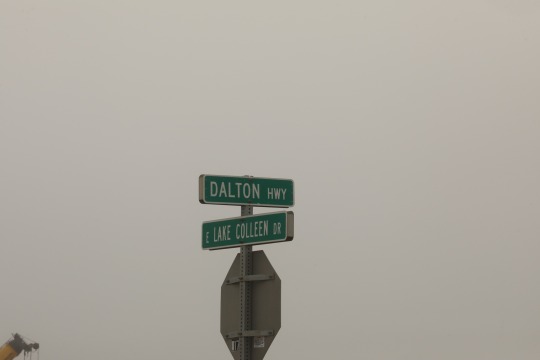

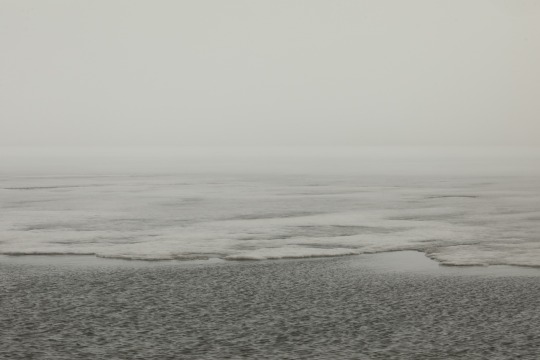



Deadhorse, Alaska
Taken June 2023
#deadhorse#dalton highway#arctic gothic#north slope#brown bears#eastern yellow wagtail#alaska#signs#my photos#my places#rlwtstcwtsv#oil fields#k
783 notes
·
View notes
Text
Great Backyard Bird Off - Schedule & Info
Round One Schedule
Cosmopolitan - posted February 1st & 2nd - 14 polls
Europe - posted February 11th - 9 polls
Africa - posted February 20th - 9 polls
Australia - posted March 1st & 2nd - 20 polls
New Zealand - posted March 11th - 7 polls
Asia - posted March 20th & 21st - 14 polls
the Americas - posted March 29th & 30th - 16 polls
Eurasia - posted April 8th & 9th - 14 polls
Poll Info
There are 8 brackets, with 208 species featured! Ranges were determined either using the self-report feature added to the submission box or with eBird sightings. "Cosmopolitan" is a bracket involving species of birds which were found on at least three continents, regardless of which they were submitted for. "Eurasia" are birds which seem to appear equally between Europe and Asia (majority of the continent, not just Middle East). "the Americas" includes all of the Americas, with US birds removed- granted, some Canadian or Mexican birds can show up in the US, but they're not common enough backyard birds (imo) to have been disqualified.
Please-- feel free to advocate for whichever bird you vote for! I would love to get some more participation with this tournament, especially since this is a poll with popular bird species.
Polls will be a week long, and are tagged #Great Backyard Bird Off. All subsequent reblogs are tagged as #poll reblog. Be sure to block this tag if you want to avoid me spamming your dash. Any reblogs containing support for a species will be tagged #[species] support. Results will be tagged #poll results.
Bird Support Google Form
vvv Participant List under the Read More vvv
Cosmopolitan (28 species)
Black kite, Black-headed gull, Bohemian waxwing, Canada goose, Common buzzard, C. Chiffchaff, C. Kingfisher, C. Loon, C. Myna, C. Nightingale, C. Swift, Eurasian Collared-dove, Eurasian Hoopoe, Eurasian (Common) Kestrel, Eurasian Tree Sparrow, European bee-eater, European (common) starling, Great crested grebe, Great gray owl, Grey wagtail, Little grebe, Ring-necked pheasant, Red-backed Shrike, Rock Pigeon, Rose-ringed Parakeet, Western barn owl, Western cattle egret, White (pied) wagtail
Europe (18 species)
Tawny Owl, Spotless Starling, Red kite, Middle spotted woodpecker, Great spotted woodpecker, Fieldfare, European Stonechat, E. Robin, E. Herring Gull, E. Goldfinch, Eurasian Green Woodpecker, Eurasian Golden Oriole, Eurasian blackcap, Eurasian (Common) Blackbird, Dunnock, Crested tit, Common wood-pigeon, Eurasian Blue tit
Africa (18 species)
African Harrier-hawk, Bearded barbet, Blacksmith lapwing, Bokmakierie, Cape starling, Cape white-eye, Dark-capped bulbul, Hadada ibis, House bunting, Klaas' Cuckoo, Kwevoel (Grey go-away-bird), Nile valley sunbird, Purple-crested turaco, Red-winged starling, Southern double-collared sunbird, Southern masked weaver, Spotted eagle-owl, White-backed mousebird
Australia (41 species)
Yellow Wattlebird, Willie-wagtail, White-faced Heron, Welcome Swallow, Weebill, Tawny Frogmouth, Tasmanian Nativehen, Superb Fairywren, Sulfur-crested Cockatoo, Splendid Fairywren, Sooty Owl, Red-browed Firetail, Red wattlebird, Rainbow lorikeet, Peid currawong, Pheasant coucal, Pacific koel, Noisy miner, Masked lapwing, Magpie-lark, Little corella, Lewin's honeyeater, Laughing kookaburra, Grey fantail, Grey butcherbird, Gang Gang cockatoo, Galah, Eastern spinebill, Eastern rosella, Crimson rosella, Crested pigeon, Crescent honeyeater, Bush stone curlew (thick-knee), Brown thornbill, Black swan, Bell miner, Austarlian ringneck, Australian magpie, Australian Ibis (Bin Chicken), Australasian Swamphen (Pukeko)
New Zealand (14 species)
Kaka, Kakaruwai (South Island robin), Karearea (NZ falcon), Kereru, Koekoea (Long-tailed Koel), Korimako (NZ bellbird), Yellowhead, Piwakawaka (NZ Fantail), Riroriro (Grey Gerygone), Satin Bowerbird, Silvereye (Tahou), Titipounamu (Rifleman), Tomtit, Tui
Asia (28 species)
Asian Koel, Azure-winged Magpie, Black-collared Starling, Brown-eared Bulbul, Colombo (House) Crow, Common Hill-myna, Eastern Buzzard, Japanese Robin, Light-vented Bulbul, Mandarin Duck, Masked Laughingthrush, Olive-backed Sunbird, Oriental Magpie-robin, Oriental Pied Hornbill, Palau Fruit dove, Palla's Gull, Purple-rumped Sunbird, Red-billed Blue magpie, Red Junglefowl, Red-whiskered bulbul, Ruppell's Weaver, Southern Hill-myna, Spotted dove, Swinhoe's White-eye, Whistling Green-pigeon, White-rumped munia, White-spectacled bulbul, Yellow bittern
The Americas (33 species)
Austral Thrush, Bananaquit, Blue-and-white Swallow, Blue-and-yellow Macaw, Bushy-crested Jay, Canada Jay, Chalk-browed Mockingbird, Chimango, Clay-colored Thrush, Common Potoo, Crimson-fronted Parakeet, Eared Dove, Great Kiskadee, Great Thrush, Green-backed Firecrown, Green-headed Tanager, Hoatzin, Lesson's Motmot, Masked Water Tyrant, Pacific Hornero, Pale-breasted Thrush, Plain Parakeet, Red-rumped Cacique, Ruddy Ground Dove, Rufous Hornero, Rufous-bellied Thrush, Rufous-collared Sparrow, Russet-naped Wood rail, Sayaca Tanager, Southern House Wren, Southern Lapwing, White Bellbird, White-crested Elaenia
Eurasia (28 Species)
Black Redstart, Blue Rock thrush, Carrion Crow, Coal Tit, Common Chaffinch, Eurasian Bullfinch, Eurasian Bittern, Eurasian Jackdaw, Eurasian Jay, Eurasian Magpie, Eurasian Nuthatch, Eurasian Oystercatcher, Eurasian Siskin, Eurasian Sparrowhawk, Eurasian Treecreeper, Eurasian Wren, European Greenfinch, Goldcrest, Great Tit, Hawfinch, Hooded Crow, Long-tailed Tit, Mistle Thrush, Northern Lapwing, Rook, Song Thrush, Spanish Sparrow, Yellowhammer
#great backyard bird off#poll info#tbf this post is as much for me as it is for yall#i just need to get better at planning bc of school and all#but I really love running this blog#hopefully this poll is big enough to carry us through most of the year!
18 notes
·
View notes
Note
hello there! I see you enjoyed learning that willie wagtails exist, so here are some more cool looking birds:

This is a pink robin, found in southeast Australia but more common in Tasmania.

This is an eastern yellow robin. As the name implies, they are found all along Australia's eastern coast. A lucky birdwatcher could see a yellow and a pink robin at the same time!

This is a white-browed tit warbler, found in China, Nepal, and Kyrgyzstan.

This is a southern emu-wren, found across Australia's southern coast and Tasmania.
Here's what I think you'll enjoy the most:
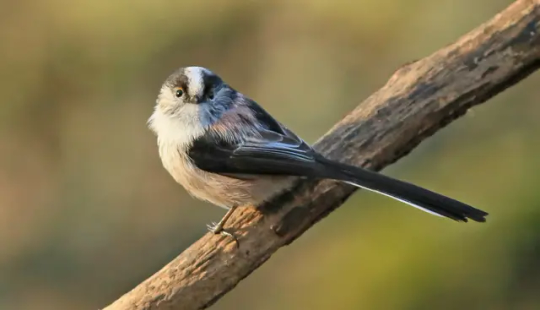
This is a long-tailed tit. Their species is found across Eurasia, but are most common in Europe and Japan. This one's from Europe, ones from Japan...
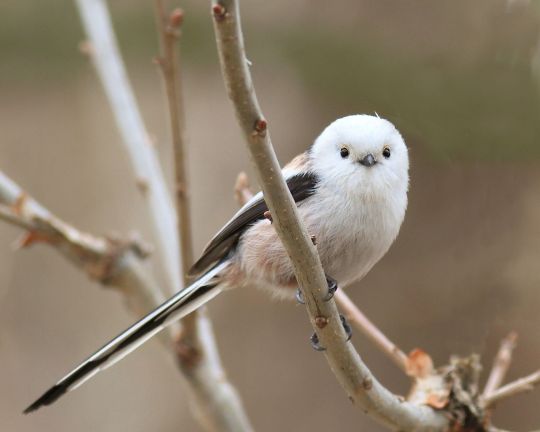
...look like this!
And finally, a picture of my mixed-morph cockatiel, Mittens.

Have a great day!
*in tears (in a good way) thank you mr birdenjoyer...
2 notes
·
View notes
Text
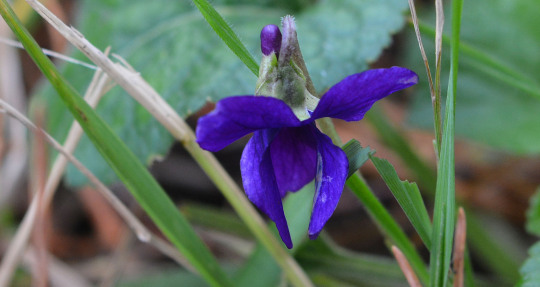

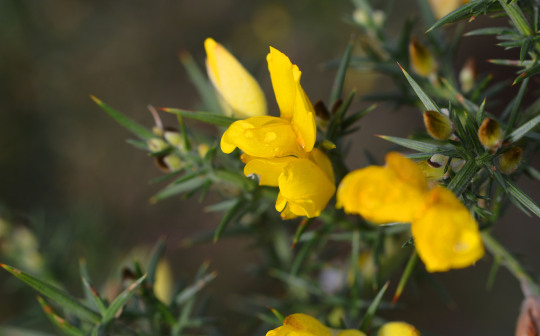
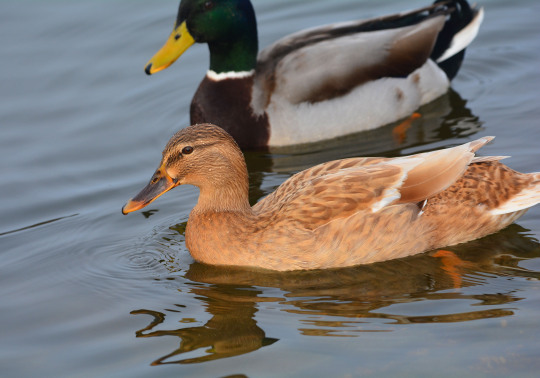
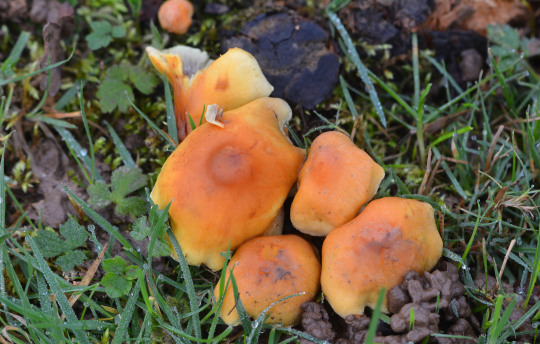
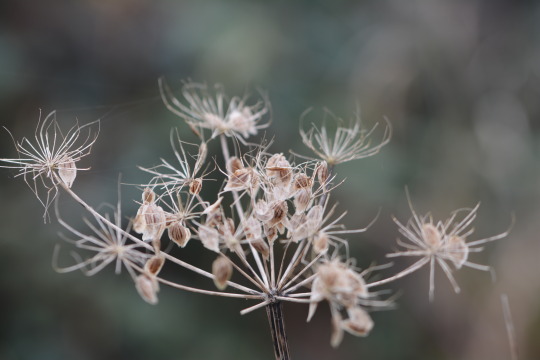
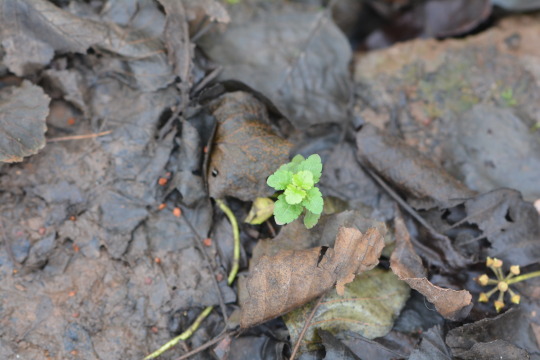


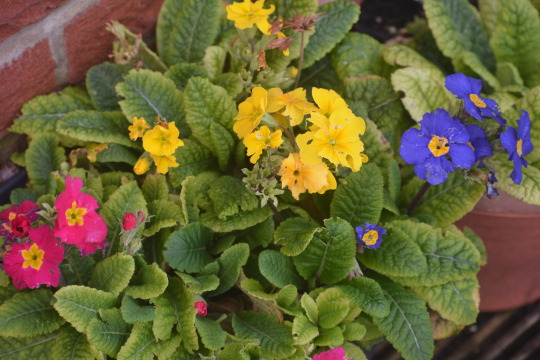
26/12/2023-Boxing Day walks at Lakeside Country Park and bits at home
Flora, fauna and fungi photos taken in this set: 1. A pretty violet I was pleased to find at Lakeside, a key early spring flower for me as the notable point of a fair few flowers being still in flowers morphs into certain species being out in flower early. A fitting flower to see today as that was my Nan's name who always helped make Christmas magical for me as a kid. 2. Woodpigeon in the woods. 3. Bright yellow gorse flower adorned by water droplets. 4. Mallards including an interestingly coloured female. 5. Mushrooms in the southern fenced off area, possibly sulphur tuft. 6. Golden hogweed seed heads. 7. Some speedwell leaves in the woods which have caught my eye of late with some slime mould in shot possible carnival candy slime mould which I've seen a fair bit of lately. 8. Blackthorn sloes which are interesting to see in the eastern meadows in the bushes. 9. An impressive display of fungi around a stump in the southern fenced off area I believe turkey tail. 10. Some beautiful and colourful flowers on the balcony.
It was a great couple of walks at Lakeside for noticing leaves and learning what species they are for some with ivy, spear thistle, clover, green alkanet, oak and bramble also standing out. Cleavers, wild carrot, horseweed, winter heliotrope, dandelion, hazel catkins, old man's beard, hawthorn, rose hips and beautiful privet berries I like their appearance were other plant highlights at Lakeside with steeplebush enjoyed at home with some shoots coming out and the camellia buds starting to form in the front garden. Moss and lichen were good to see too on the walks. Other avian highlights on my walks were vibrant Greenfinches, possible Siskin too, Ring-necked Parakeet heard, Song Thrush singing elegantly which gripped me seeing it well too, Redwings, Blackbird, Robin seen and heard well and immersive views of a Cormorant on beach lake and flying over. House Sparrow, Blue Tit, Great Tit, Long-tailed Tit, Green Woodpecker, Magpie, Jackdaw and Carrion Crow were key species seen very well again. Herring Gull, Moorhen and Great Crested Grebe were good to see too with Starlings and I believe Blue Tit heard at home and the delightful sight as I went out for my second walk of the day of a Pied Wagtail on the ground then on our roof. A great bird that we have had in the garden in winters before which we didn't last winter and not so far this so it was nice to see. I got some great views of Grey Squirrel again and by the violets a fly.
#green woodpecker#robin#song thrush#pied wagtail#photography#outdoors#outside#2023#birdwatching#walking#walk#home#eastleigh#hampshire#england#uk#nature#lakeside#lakeside country park#blackbird#greenfinch#cormorant#speedwell#green alkanet#flowers#plants#leaves#boxing day#europe#december
2 notes
·
View notes
Text

Egyptian Yellow Wagtail ~ Motacilla flava ~ Bergeronnette printanière ~ on the eastern bank of the river Nile near Cairo, Egypt
#EgyptianYellowWagtail #Wagtail #Motacillaflava #Motacilla #Bergeronnette #printanière #river #Nile #Nileriver #Helwan Cairo #Egypt #Egypte #birds #Oiseaux #birdsofegypt #birdsofinstagram #wildegypt #wildlife #closeup #Macro #wildlifephotography #birdphotography #birdphoto #oiseauxmigrateurs #oiseauxerrants #ornithology ~ https://www.flickr.com/photos/rachidh/albums
0 notes
Text
The wagtail
The wagtail is a small, agile bird belonging to the family Motacillidae. These birds are known for their long tails, which they habitually wag up and down. Wagtails are commonly found around water bodies like rivers, lakes, and wetlands, where they feed on insects and other small invertebrates. There are several species of wagtails, including the Western, Eastern, and Yellow Wagtails, each…
0 notes
Photo
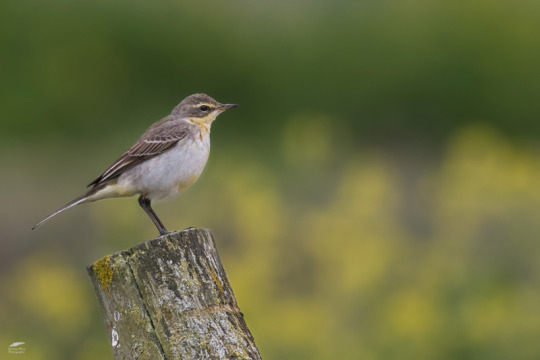
Eastern Yellow Wagtail - Alvéola-amarela-oriental (Motacilla tschutschensis)
Vila Franca de Xira/Portugal (12/02/2020)
[Nikon D500; AF-S Nikkor 500mm F5,6E PF ED VR; 1/400s; F7,1; 500 ISO]
32 notes
·
View notes
Photo
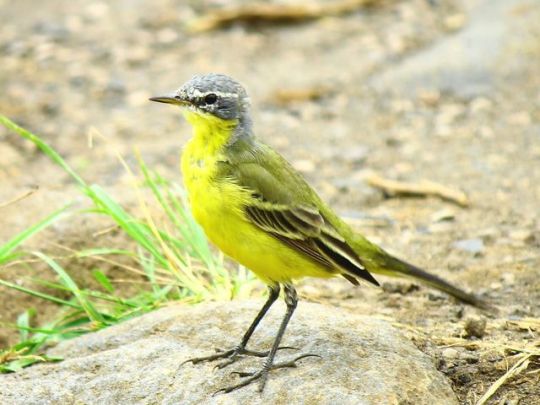
Daily Bird: Eastern Yellow Wagtail
Range: western and northern Alaska
More information: here
Photo: https : // upload . wikimedia . org/wikipedia/commons/thumb/1/1a/Motacilla_tschutschensis%2C_Tomohon%2C_North_Sulawesi.jpg/1200px-Motacilla_tschutschensis%2C_Tomohon%2C_North_Sulawesi.jpg
39 notes
·
View notes
Text
Inner-city Bird Diversity
Birds on our Balconies
We live in a small high-rise on the edge of the Melbourne CBD, on the lowest level of apartments, 6 floors above street level. We are on the intersection of two heavily trafficked streets, with constant construction and traffic noise all day and most of the night. We have two outside terraces and despite the noise and pollution, we have been visited by many birds over the years we have lived here. The list of 19 species that we have seen on our terraces is as follows:
Common Blackbirds
Grey Butcherbirds
Pied Butcherbirds
Sulphur-crested Cockatoos
Pied Currawongs
Rock Doves (Feral Pigeons)
Spotted Doves
Galahs
Silver Gulls (ubiquitous Seagulls)
White-plumed Honeyeaters
Australian Magpies
Magpie-larks
Common (Indian) Mynas
Little Ravens
House Sparrows
Common Starlings
Song Thrush (barely-fledged chick – no idea how it got there)
Red Wattlebirds
Domestic chicken (presumed escapee from a higher apartment in a nearby tower)
In addition, I have also seen regular flypasts by several of the above species as well as four more that have not actually landed on our terraces:
Peregrine Falcons
Nankeen Kestrels
Masked Lapwings
Rainbow Lorikeets
Birds nearby
Most people imagine that big cities are virtually devoid of wildlife and what there is, is limited to cats, dogs, rats, mice, sparrows and seagulls. But landings and sightings from our apartment, less than a kilometre from the centre of the city, number 23 species and I have seen at least another 15 on my walks across the Yarra into the CBD. They include:
Eurasian Coots
Little Black Cormorants
Little Pied Cormorants
Great Cormorants
Darters
Pacific Black Duck
Nankeen Night-herons
White-faced Herons
Australian White Ibises
Australian Pelicans
Welcome Swallows
Black Swans
Chestnut Teal
Grey Teal
Crested Terns
I do quite a lot of bird surveys and within a further kilometre of home, I have reported personal sightings of at least the following 41 additions.
Red-tailed Black-Cockatoo
Long-billed Corella
Black-faced Cuckoo-shrike
Black-fronted Dotterel
Red-kneed Dotterel
Maned Duck (Australian Wood Duck)
Pink-eared Duck
Great Egret
Superb Fairywren
Grey Fantail
European Goldfinch
Australasian Grebe
Hoary-headed Grebe
Common Greenfinch
Pacific Gull
Hardhead
Swamp Harrier
New Holland Honeyeater
Sacred Kingfisher
Eastern Koel
Musk Lorikeet
Bell Miner
Noisy Miner
Dusky Moorhen
Spotted Pardalote
Red-rumped Parrot
Little Penguin
Crested Pigeon
Red-capped Plover
Australian Reedwarbler
Crimson Rosella
Sharp-tailed Sandpiper
White-browed Scrubwren
Silvereye
Grey Shrike-thrush
Royal Spoonbill
Yellow-billed Spoonbill
Pied Stilt
Australian Swamphen
Willy Wagtail
Little Wattlebird
Who would have thought I could possibly have seen 79 different species of urban birds within a kilometre of Southbank – in an area of less than 4 square kilometres? Other people have obviously seen other species as well, so maybe this figure might be closer to 90 species. The landscape is certainly not barren, but I am lucky. I live close to large areas of saltwater, freshwater, marshland, luxuriant parks and gardens with a good range of habitats for so many species. Away from this area, the variety and abundance of wildlife is rarely as prolific.
2 notes
·
View notes
Text
Padma Purana, ch 74 (Arjuna’s Wish and Its Fulfilment) [excerpts]
Then, having bathed in this lake, and having gone to the bank of the eastern lake, and having bathed in its water, accomplish your desire (i.e. desired object).”
Then having heard the words, when Arjuna plunged into the water of the lake, which was tinged with the pollen dropped from white lotuses, lotuses opening on moonrise, (other) lotuses and red and blue lotuses, and which was agree- ably perfumed with honey-drops, which was shaken by the notes of corpulent swans, whose four banks were decked with jewels, which had ripples due to gentle breezes, she vanished just there. The charmingly smiling one got up and on seeing around, was confused.
He instantly saw himself (to be turned into) a wonderful, excellent lady, who had a slim, fair, charming body like the rays of pure gold, whose age was that of a sparkling youth, whose face resembled the autumnal moon, whose hair was very dark, curly, glossy and shining with jewels, whose curls of hair on the plate (-like forehead) were brightened up due to the rays from the mark of red lead, who had vanquished Cupid’s bow due to the knittings of the creeper-like eyebrows being manifest, whose wagtail-like eyes were dark like clouds and sportive, whose round cheeks were sparkling due to the bright lustre of the jewelled ear-rings, whose wonderful creeper-like arms were delicate like lotus-stalks, whose sprout-like hands took away all the beauty of autumnal lotuses, who had put on a waist-band made of gold and arranged cleverly, whose hips were shining with jingling girdles, whose beautiful place of hips was covered with a shining garment, whose lotus-like feet were very charming due to the jingling jewelled anklets, who possessed the skill in the various arts of love being manifested, who was endowed with all {good) characteristics, who was adorned with all ornaments.
Due to the illusion of (i.e. created by) the lover of the cowherdesses he forgot whatever belonged to his former body; and after that, being very much astonished, stood there, not knowing what to do.
[... interlude with goddesses including Radhika]
She saw Krishna whose hair was very glossy, dark, curly and fragrantly perfumed; on whose head was tied the best tail of a peacock intoxicated with madness; on whose left side was the ear-ornament of flowers resorted to by bees; who was shining with the mirrors of his cheeks, bright with the bee-like hair; who was shining with the beauty of the large forehead having a beautiful mark; whose nose was lovely like the sesamum-flower and the eagle’s beak ; whose lips were charming and like the bimba fruits; who inflamed passion of love with his gentle smile; who looked lovely due to the necklace resembling a wild flower; whose both large and charming shoulders were shining with the garland (of the flowers) of the divine tree, resorted to by thousands of intoxicated female bees; who was adorned with the Kaustubha on the region of the chest shining with a pearl necklace; who had the mark of Srivatsa, who was attractive on account of his hands hanging up to the knees; who was very handsome on account of having his waist like that of a lion and with a deep navel; who was lovely due to not long and very round knees like a good tree; who was adorned with excel- lent ornaments like bracelets, armlets, and anklets; whose hips were covered with a portion of his yellow garment ; who had vanquished a crore of Cupids in beauty by means of his loveliness; who enchanted (others) by means of charming songs proceeding from his flute; who made the three worlds plunge into the ocean of happiness; who had the arrogance of Cupid in every part of his body; who was tired due to his interest in dancing.
There were deities appointed at respective places, observing his internal feelings, having fixed their eyes on his face, who were in due order and with respect carrying separately a chowrie, a fan, a flower, a perfume, sandal, and tambula, a mirror, a drinking vessel, a spitting pot, and also other objects of sport, so also frankincense and an amulet.
Arjunlya, having seen in confusion on the left side of the pleasing goddess Radhika, propitiating and offering a tambula to him of a bright smile, was overcome with the passion of love.
Then Krishna, who knew everything, knowing her to be like that, seized her hand, and he the lord, the great master of magical art secretly sported with her in the entire pleasure-forest.
Then putting his sport-like arm on her shoulder and coming to Sarada, said to her: “Bathe quickly this slim-bodied lady of a gentle smile, fatigued due to sport, in this western lake.” Then that goddess Sarada (took her) to the western lake, (and) said to her, “Take bath”.
The fatigued one did like that. She who got to the interior of the water, again turned into Arjuna and got up at the place where the lord of gods and the chief of the beautiful Vaikuntha stood. Seeing Arjuna dejected and broken-minded, Krishna kindly touched him with his hand and put him (back) to his nature.
(https://archive.org/stream/in.ernet.dli.2015.100006/2015.100006.The-Padma-purana-Part-6_djvu.txt)
for @parlegee
7 notes
·
View notes
Text

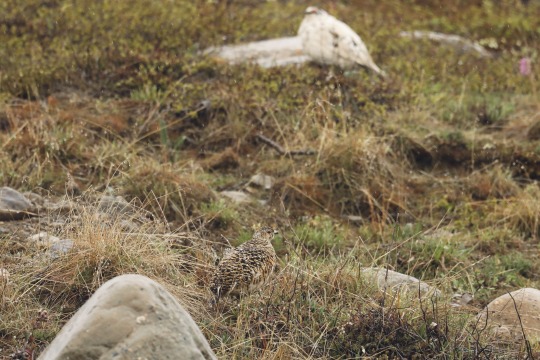
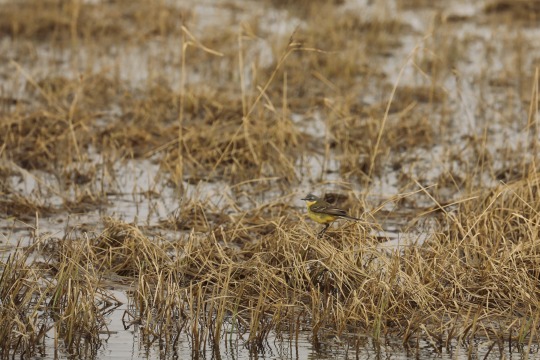

Camouflage on the arctic tundra near Deadhorse, Alaska
Taken June 2023
#eastern yellow wagtail#smith's longspur#northern pintail#rock ptarmigan#birds#my photos#tundra#arctic#alaska#north slope#dalton highway#rlwtstcwtsv
176 notes
·
View notes
Photo

東黃鶺鴒 Eastern Yellow Wagtail @hk.wetlandpark @afcdgovhk 東黃鶺鴒喺香港受野生動物保護條例 (第170章) 保護。 Eastern Yellow Wagtail in Hong Kong protected by WILD ANIMALS PROTECTION ORDINANCE (CHAPTER 170) #香港 #生態 #香港生態 #大自然 #香港大自然 #觀鳥 #香港觀鳥 #東黃鶺鴒 #新界 #天水圍 #濕地公園路 #香港濕地公園 #hkwetlandpark #afcdgovhk #CarmenKennyLukeYip #HongKong #Ecology #HongKongEcology #Nature #HongKongNature #BirdWatching #HongKongBirdWatching #EasternYellowWagtail #NewTerritories #TinShuiWai #WetlandParkRoad #HongKongWetlandPark #hkwetlandpark #afcdgovhk #CarmenKennyLukeYip(在 香港濕地公園) https://www.instagram.com/p/Ck2uZRDygld/?igshid=NGJjMDIxMWI=
#香港#生態#香港生態#大自然#香港大自然#觀鳥#香港觀鳥#東黃鶺鴒#新界#天水圍#濕地公園路#香港濕地公園#hkwetlandpark#afcdgovhk#carmenkennylukeyip#hongkong#ecology#hongkongecology#nature#hongkongnature#birdwatching#hongkongbirdwatching#easternyellowwagtail#newterritories#tinshuiwai#wetlandparkroad#hongkongwetlandpark
0 notes
Photo
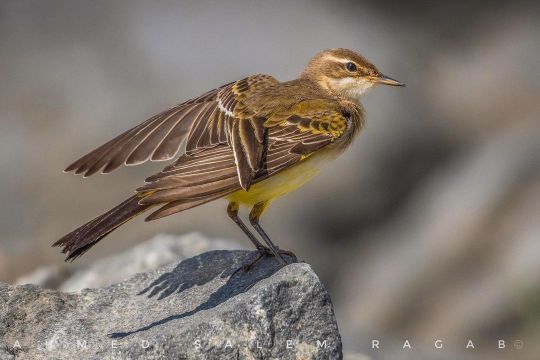
ذعرة صفراء يسمى أيضاً أبو فصادة او صعوة (الاسم العلمي: Motacilla flava) (بالإنجليزية: Western Yellow Wagtail) هو طائر ينتمي إلى طيور التمرة وأم عجلان (فصيلة: Motacillidae). عرف بـ (صعوة) نسبة إلى صغر حجمها. طائر مهاجر عابر شائع ومنتشر في موسم الهجرة الشتوية والربيعية، يألف المناطق ذات الغطاء النباتي المروّي المناطق الزراعية، والأراضي المكشوفة. يصل طول الجسم إلى 16،5 سم تقريباً، يتميز الذكر عند التكاثر بأن السطح الظهري ومؤخرة الذيل أخضر زيتوني، ويغطي السطح البطني اللون الأخضر مع بياض في أطراف ريش الذيل، أما ريش رأس الطائر فيتميز تبعاً للنوع وغالباً يكون أصفر أو الزيتوني، حيث تتباين ألوان ريش رؤوس الذكور في الصيف: ذكر ذو الرأس الأزرق: حيث يغطي اللون الأزرق الرمادي قمة الرأس ومؤخرة العنق والأذن، ويمتد اللون الأبيض أسفل المنقار، الذقن أبيض اللون، الزور أصفر اللون. ذكر ذو الرأس الأسود: حيث يغطي اللون الأسود الرأس، والذقن أصفر اللون. ذكر ذو الرأس الرمادي: حيث قمة الرأس ومؤخرة العنق رمادي اللون، وتغطي الأذن بلون الأسود، والذقن أبيض أو أصفر اللون، ويغطي اللون البني السطح الظهري للذكر والاناث في الشتاء، ويكون السطح البطني أفتح لوناً. يتكاثر في الفترة ما بين مايو إلى يوليو، وتضع الأنثى من 5 إلى 6 بيضات في أعشاش من النباتات في مخابئ على الأرض. ويلاحظ أن الصعوة والسلحوت يشابهان ف الشكل ولا يتشابهان في اللون. يتغذى على الحشرات والديدان وهو يحرك ذيله باستمرار إلى أعلى وأسفل، أثناء التغذية. ============= @boyahia ============= The western yellow wagtail (Motacilla flava) is a small passerine in the wagtail familyMotacillidae, which also includes the pipitsand longclaws. This species breeds in much of temperate Europe and Asia. It is resident in the milder parts of its range, such as western Europe, but northern and eastern populations migrate to Africa and south Asia. It is a slender 15–16 cm long bird, with the characteristic long, constantly wagging tail of its genus. It is the shortest tailed of the European wagtails. The breeding adult male is basically olive above and yellow below. In other plumages, the yellow may be diluted by white. The heads of breeding males come in a variety of colours and patterns depending on subspecies. (at شاليهات الدوحه الشرقيه) https://www.instagram.com/p/CU4plmbKeBt/?utm_medium=tumblr
0 notes
Text
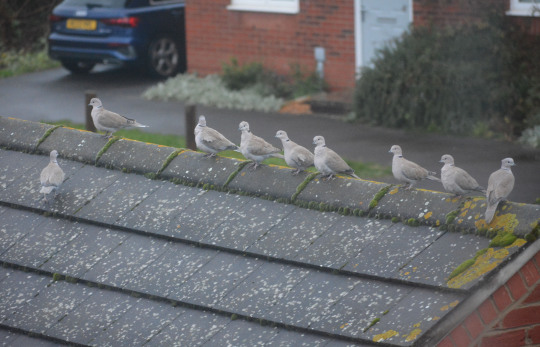
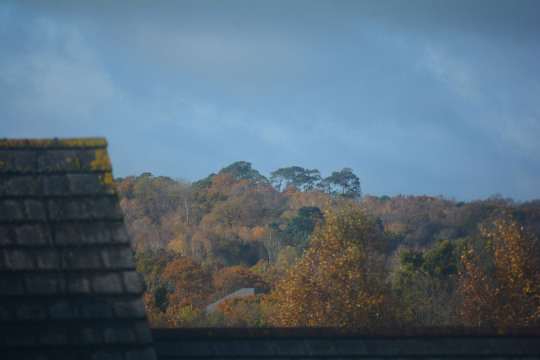


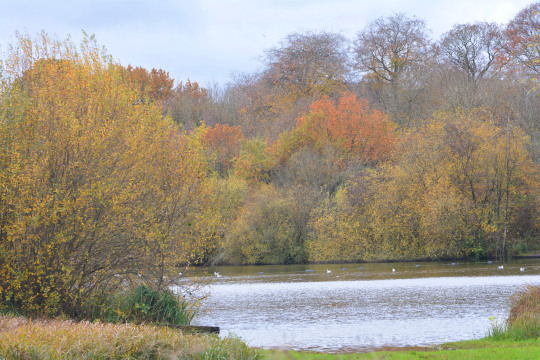
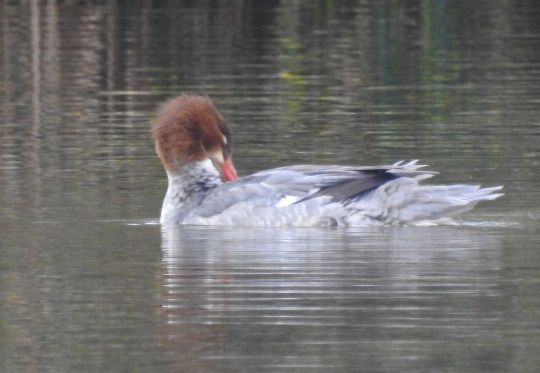
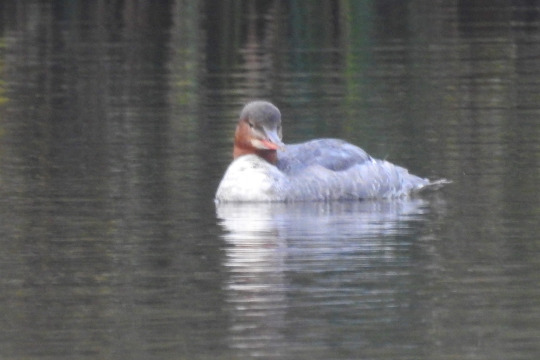
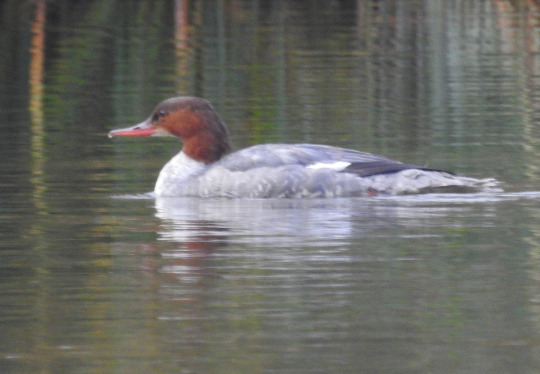


20th November 2023: Lakeside and home
Photos taken in this set: 1. A nice gang of Collared Doves out the back this morning. 2 and 10. Autumnal colours afar out the back and on the tree nearby with a fair few yellow leaves hanging on still. 3, 4 and 5. Beautiful views at Lakeside with real mature autumn colour in the landscape now which I was thrilled to be immersed in. 6, 7 and 8. Some photos of the two Goosanders which it was amazing to see again, they'd relocated to beach lake now. It was a joy to observe them for a little bit once more with their dashing red heads and neat appearance. These are such wonderful birds to have so close to home and be able to see on my lunch break and I'm loving seeing them. 9. More duck delight, one of my first two Tufted Ducks of the winter seen here, males on Concorde lake.
I saw a great list of birds at Lakeside at lunch time also including a Kestrel flying over the southern fenced off area with Magpies which was a thrilling moment. A charm of Goldfinches flying over gave me a warm feeling and it was a delight to see a Mistle Thrush again what a key bird for me at Lakeside this year. A Kingfisher dashing over beach lake, Robin, Moorhens including once entertainingly seen on a buoy on beach lake again, Great Crested Grebes and a couple of wagtails flying over the bowl area one definitely a Grey Wagtail with its sweet yellow chest and the other I couldn't quite get a clear enough view of logically another grey but possibly a Pied Wagtail with it as I'd seen one of each together in the opposite corner of the park a few weeks back were other highlights. The bowl in the eastern meadows a quirky place to see a grey. It was good to see Goldfinch and Magpie at home today too. Daisy, wild carrot still going along the northern path, rose hips, hawthorn berries and holly berries were plant highlights at lunch time.
#birdwatching#goosander#ducks#duck#tufted duck#moorhen#great crested grebe#kingfisher#kestrel#water birds#goldfinches#mistle thrush#grey wagtail#2023#outdoors#photography#walking#walk#europe#lunch time walk#collared doves#november#autumn#happy#outside#birding#wildlife
4 notes
·
View notes
Link
240 Eastern Yellow Wagtail by William--King #impressionism #fineart #limitededition #abstract #painting #drawing #art #digital #prints #originalart #wildlife #animals #birds #nature #countryside
#art#drawing#painting#birds#animals#wildlife#nature#countryside#bird#digital#prints#originalart#fineart#impressionism
0 notes
Photo
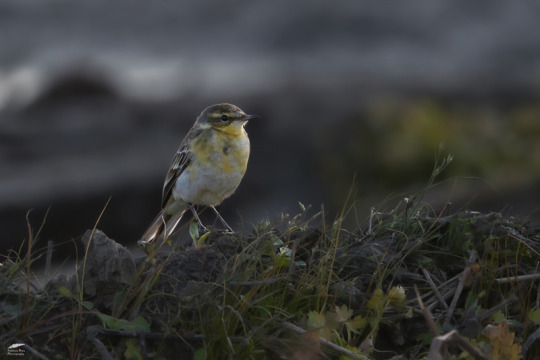
Eastern Yellow Wagtail - Alvéola-amarela-oriental (Motacilla tschutschensis)
Vila Franca de Xira/Portugal (6/03/2020)
[Nikon D500; AF-S Nikkor 500mm F5,6E PF ED VR with Nikon AF-S TC-14E III; 1/800s; F8; 400 ISO]
20 notes
·
View notes